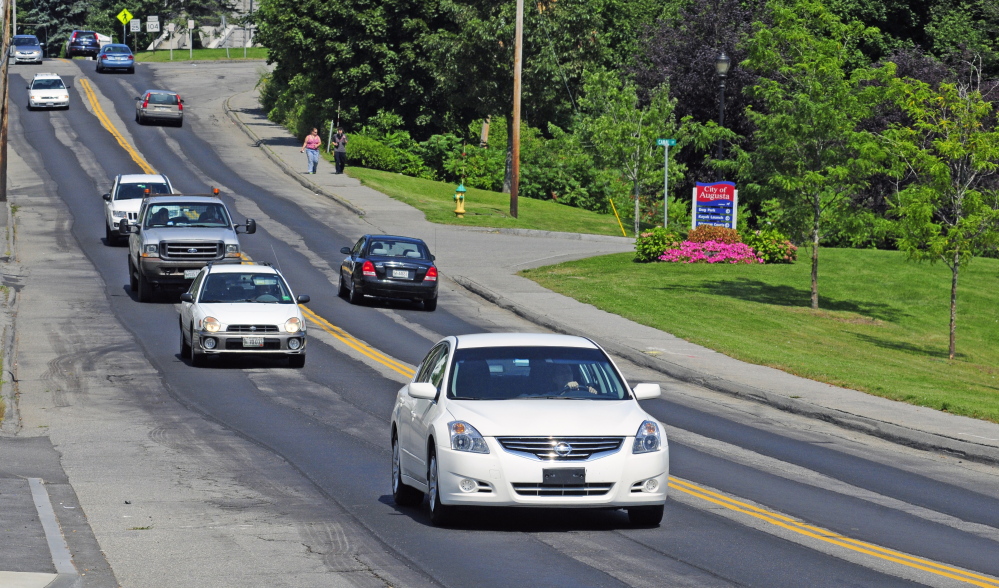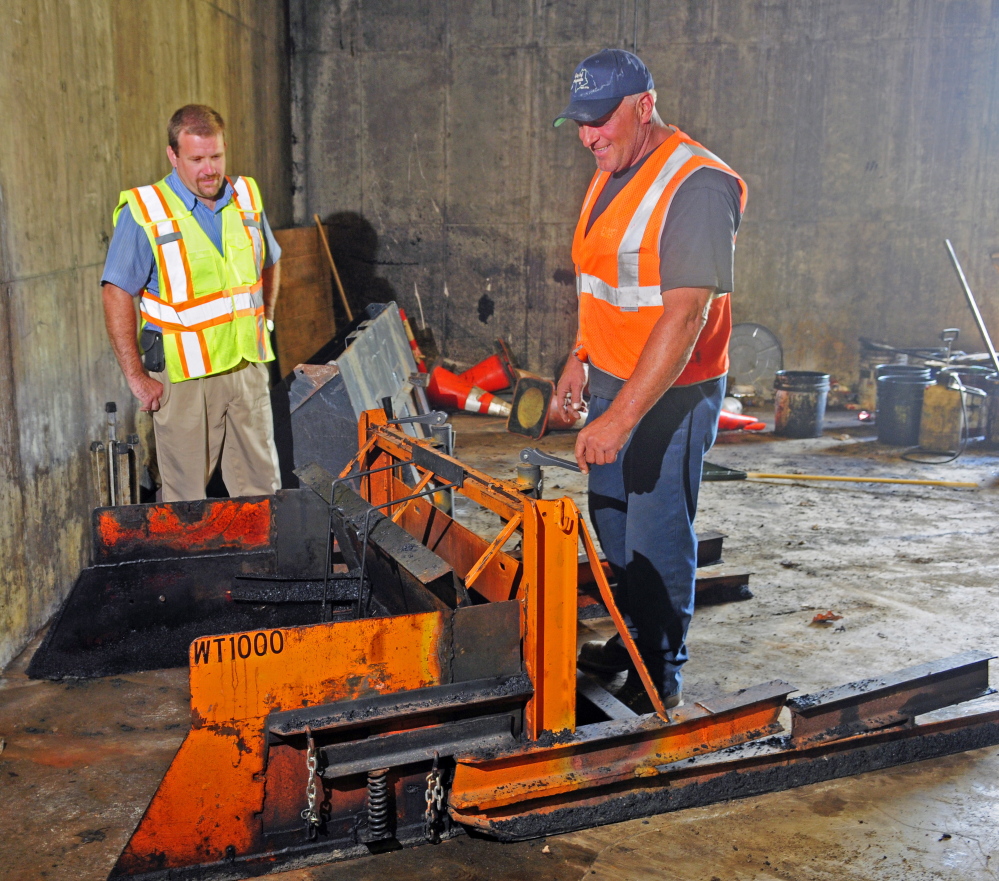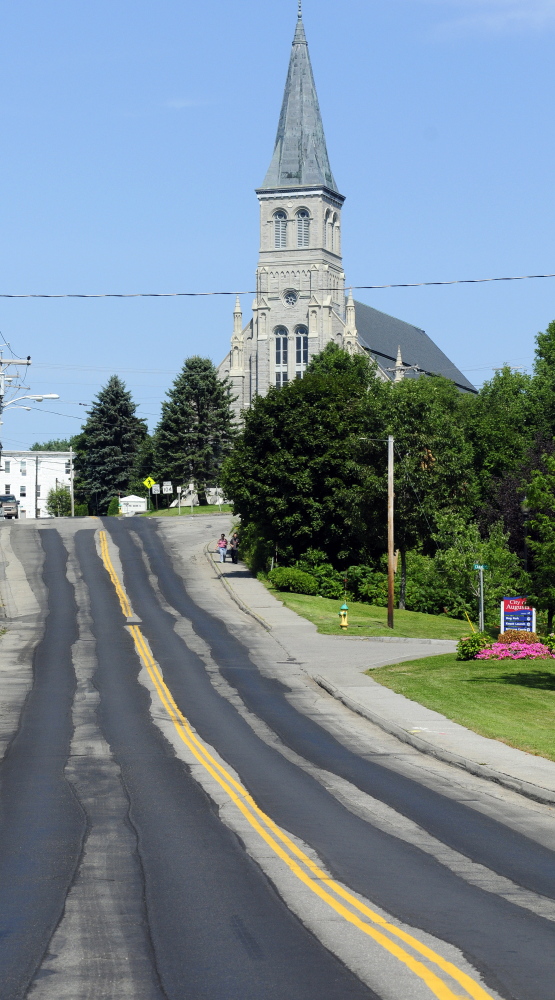AUGUSTA — An idea hatched in foreman Mike Morrison’s head and assembled by his fellow Augusta Public Works paving crew members out of parts salvaged off an old dump truck is saving taxpayer money, materials and workers’ backs on paving jobs throughout the city.
Morrison, tasked by street superintendent Jerry Dostie to come up with ways the city could stretch its paving budget further to better address ever-deteriorating roads, designed and, with the paving crew, built a device that helps put down level strips of new pavement on rough, uneven, potholed and rutted roads that otherwise would require a full and much costlier shim coat or a full repaving.
The device, Dostie said, saves the city money by cutting the amount of paving materials by 35 percent to 40 percent compared to the more traditional, two-coat process, and also is used to extend the life of pavement on well-traveled roads such as Northern Avenue until a full repaving can be done.
It also is used on jobs that were done previously by crews hand-raking pavement mix, which can be a back-straining and time-consuming job. Morrison said the city’s paving crew repaired a section of Route 3 to the Vassalboro line a few years ago, raking pavement mix by hand. It took three weeks. He said it probably would take only three days with the device, which his crew has dubbed the WT 1,000, for wheel track paver, because the device paves in wheel tracks and other low spots in roads.
“I’m a taxpayer too,” Morrison said, explaining his motivation to create the labor- and material-saving device. “The only thing we had to buy was a couple of handles. For everything else, we used what was in the backyard.”
The machine mounts to the bucket of a skid steer, which pushes it along as a dump truck drives, slowly, ahead of it, depositing pavement mix that the device then levels, spreads out and pushes down into the road surface’s low spots. It is followed by a roller, which compacts the pavement.
Dostie said while it’s hard to calculate the exact savings resulting from the use of the WT 1,000, it reduces the amount of materials used on a typical job by up to 40 percent, which can mean several thousand dollars’ worth of savings on a single job, depending on the length of road. On the Northern Avenue project, he estimates it saved about $5,000.
That project greatly smoothed the travel surface of Northern Avenue and, Dostie said, should extend the life of the existing pavement until the road can get a full repaving job. He said without the WT 1,000, the project probably wouldn’t have been done, because it would have been too costly.
The nature of the work done by the machine did leave Northern Avenue with a sort of half-completed look to it. Two strips of fresh-looking black pavement are in the travel lane, where they fill wheel ruts left where most vehicles’ wheels travel. A strip of grayish older pavement remains between the two strips of newer pavement.
Dostie and Morrison said they’ve gotten some questions from travelers about the unusual looking road surface,, but they’ve also heard from many others who’ve noticed how much smoother the ride is now.
“We put the mix where it’s needed, and not where it isn’t,” is how Morrison explains the unusual-looking pattern. “Northern Avenue was not going to be done without it. At least you don’t spill your coffee there now.”
Dostie said before Morrison and his crew made the device, they looked around for a commercially available machine that could do the job. They found none, although Dostie said that in the time since it was built, they have seen somewhat similar devices.
About the only thing new on the machine is a set of handles and jacks used to raise and lower the device for varying road conditions, to adjust the depth of the mix used. The rest was salvaged from what was already sitting around unused at public works. Morrison estimated it took about eight hours to build.
“We provided the jacks and handles, and everything else was stuff we had around, off an old dump truck body,” Dostie said. “We didn’t know if it was going to work at first, so we didn’t want to invest a lot of money.”
Morrison, an Augusta resident who has worked for the city for some 20 years and in the paving industry for some 35 years, said he knew it would work.
Dostie noted the machine indirectly saves the city money on ice-removal costs. That’s because wheel ruts can fill up with snow and ice in the winter and, because they are lower than the rest of the road surface, snowplows can’t remove the snow and ice from the ruts fully. So the snow sits in the ruts and hardens, or more salt needs to be used to remove it.
The orange and now partially pavement-blackened steel device has been used on paving projects on roads including Northern Avenue, Townsend Road, North and South Belfast avenues, Bolton Hill Road, Mount Vernon Road and Leighton Road
“It’s pretty basic, but it does a lot of work and there is a lot of savings,” Dostie said. “Raking is also not good for backs.”
Morrison said he designed the rig in his head, based upon his many years of paving.
“The guys are pretty tickled with it,” he said of the WT 1,000. “I had the idea in my head, and (the paving crew) built it. They don’t like raking either.”
Dostie noted the machine has dual roles. It can be used to prepare a road for a final coat of pavement by filling in the wheel ruts and other low points. Without the unit, a full shim coat would be required to prepare uneven roads for final paving. And on projects such as Northern Avenue and Townsend Road, it is used to extend the life of the road by filling in ruts and other rough spots, which deters the formation of potholes.
He stressed the machine is not a substitute for a full paving job.
Dostie noted some of the material placed by the machine probably will get scraped off by snowplows over the winter, but he expects the majority of it to remain in place and last two to five years.
“It’s not a substitute for paving, but it has allowed us to be more efficient and productive,” Dostie said. “It gives us 35 to 40 percent savings in materials, so we can use those materials elsewhere. It’s another tool in our toolbox of preserving pavement and stretching our limited paving dollars.”
Keith Edwards — 621-5647
kedwards@centralmaine.com
Twitter: @kedwardskj
Copy the Story LinkSend questions/comments to the editors.






Success. Please wait for the page to reload. If the page does not reload within 5 seconds, please refresh the page.
Enter your email and password to access comments.
Hi, to comment on stories you must . This profile is in addition to your subscription and website login.
Already have a commenting profile? .
Invalid username/password.
Please check your email to confirm and complete your registration.
Only subscribers are eligible to post comments. Please subscribe or login first for digital access. Here’s why.
Use the form below to reset your password. When you've submitted your account email, we will send an email with a reset code.